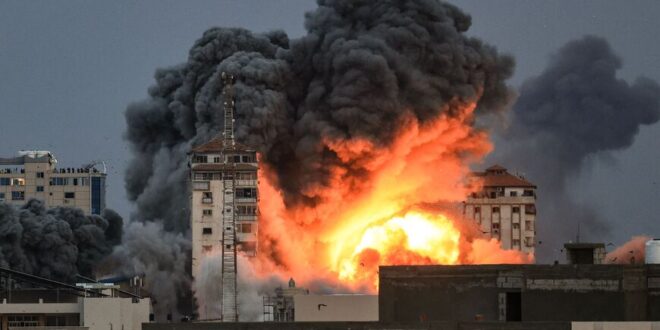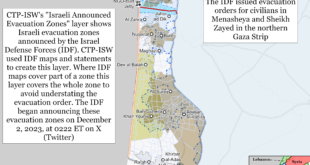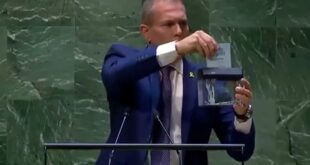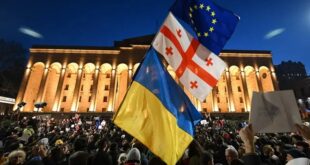The US-brokered talks were making progress; that’s probably why Iran gave Hamas the green light.
This column was supposed to be about the momentum and promise of the US-brokered Saudi-Israel peace initiative, including how the kingdom went big by making Israeli-Palestinian peace part of the deal.
The consequences of an Israel-Saudi peace deal, led by the United States and providing new hope for a comatose Israeli-Palestinian peace process, were potentially game-changing for the region.
And that’s why Iran, it seems, looked to upend the process.
The attack from Hamas, a key partner in Iran’s “resistance axis” (which also includes Syria, Hezbollah and various Iraqi factions), was stunning in its execution. The operation from Gaza included not just 3,000 rockets, but an actual invasion into southern Israeli cities. An Israeli death toll of around 300 (as we went to press) and dozens of hostages are unprecedented.
The Hamas takeover of the Erez border crossing, which was key to the operation, was witnessed by Al-Monitor’s correspondent in Gaza; you can read the report here.
The scope and sophistication of the attack, which caught Israel completely by surprise, will haunt Prime Minister Benjamin Netanyahu even after the war ends. That Hamas (an Arabic acronym for the Islamic Resistance Movement) chose the 50th anniversary of the Yom Kippur War to launch this operation is salt in the wound. Although the 1973 attack by Arab armies was also a surprise and the intelligence regarding the preparation for the assault was sound, Tel Aviv just didn’t think they would do it. This time around, there was no clue.
Netanyahu now faces the biggest crisis of his political career, Ben Caspit reports from Tel Aviv.
“Israel’s retaliation against Hamas will be vastly complicated by the presence of Israeli hostages in the organization’s Gaza tunnels and other sites in the densely crowded strip,” writes Caspit, while “at the same time seeking to prevent escalation on other fronts — Hamas and other jihadist forces in the West Bank and Hezbollah deployed along its border with Lebanon and heavily armed with missiles.” Iran also has sway with the jihadists in the West Bank and of course with Hezbollah, and therefore can trigger or contain any escalation of the conflict.
In a way, the surprise and sophistication of the Hamas operation recalls the Iranian drone and missile attacks on Aramco in September 2019.
While neither Hamas nor Iran have acknowledged Tehran’s role in the planning of the operation, it’s almost certainly a safe bet that Tehran at the very least gave the green light.
From Iran’s perspective, it was time to show that its influence along the Palestinian fault line was stronger than ever, especially as US-Israel-Saudi-Palestinian talks gained traction. Iran has been mostly content with its influence in Iraq, Syria and Lebanon via Hezbollah. Relations with the Arab Gulf states are on a diplomatic track. Iran would have felt a harsh message needed to be sent via Israel.
Iran’s presumed hand in this operation does not negate the local politics involved.
That Saudi Crown Prince Mohammed bin Salman had dealt the Palestinian Authority into the Saudi-Israel agreement was a call to action in Gaza. Palestinian President Mahmoud Abbas has been losing ground to Hamas and other more radical groups in the West Bank. Palestinians increasingly lost faith in his leadership and the prospects of another peace deal, having felt left behind by the Abraham Accords, as Ahmed Melhem reports from the West Bank.
Hamas, and by extension Iran, wanted to snuff out any lifeline to the PA and reassert the dominance of the resistance movements and armed groups, which have been gaining ground.
Hamas political head Ismail Haniyeh took direct aim at Israel-Arab normalization, saying Israel “cannot protect itself in the face of resistors, cannot provide you with any protection. … All the normalization agreements that you signed with that entity cannot resolve this conflict.”
Hezbollah made a similar connection, calling Hamas’ attack “a message to the Muslim and Arab nations as well as to the international community, especially those who are rushing to normalize ties with the Zionist entity, that the Palestinian cause is alive till victory and liberation.”
There is no status quo in the Middle East; things get better or worse, even when you’re not paying attention. Netanyahu has for years avoided any serious engagement with the PA, even at times preferring to deal with Hamas. With no peace process, Abbas has had nothing much to offer his people; Hamas and others have filled the void in the West Bank.
And now it’s worse. Netanyahu’s radical right coalition partners cannot even entertain the thought of concessions to the Palestinians. Their constituents are among the most ideological and virulent among the settler movement. Many never served in the army. Hamas named its operation “Al-Aqsa Flood,” linking its attack to recent provocations by Israeli religious extremists and settlers at the Al-Aqsa Mosque, sacred to all Muslims.
Nor has Bibi implemented agreements with the Palestinians going back as far as 1993, while looking the other way as radical right settlers built even more settlements and illegal outposts. The first item of February 2023 Aqaba Agreement signed by Israel, Jordan, Egypt, the PA and the United States is to reaffirm Israeli and Palestinian commitment to all previous agreements.
None of this excuses the atrocities committed by the Hamas terrorist attack on innocent Israelis. The costs will be heavy for Palestinians as well, thanks to Hamas. In addition to the Israeli casualties, 232 Palestinians civilians have already been killed, mostly the result of Israelis airstrikes in Gaza that will intensify in the coming days.
And this brings us back to where we started: the Saudi-Israel peace deal, which appears, at least for now, a casualty of the Israel-Hamas war. Let’s hope it’s only a temporary casualty.
Daoud Kuttab, author of the Al-Monitor Palestine Newsletter, told me today that the diplomats can only begin doing their work when the bullets and bombs stop doing theirs.
That may be a while, but once the fighting stops, the Saudi-Israel deal needs to be back in play. More than ever, an Israeli-Palestinian peace plan needs to be linked to a broader regional realignment.
US President Joe Biden and MBS have been on the right track with the Palestinians as a key step in the Saudi-Israel normalization process. US Secretary of State Antony Blinken called on his Saudi counterpart Prince Faisal bin Farhan “for coordinated efforts to achieve an immediate halt to the violent attacks by Hamas terrorists and other militants.”
Once the fighting is over, if Netanyahu survives politically, he will want the Saudi peace deal. It’s not too early to be thinking about the end game. Perhaps a national unity government including opposition leader Yair Lapid and National Unity Party leader Benny Gantz will give Netanyahu the cover needed to make a deal with the Palestinians. Gantz, who was in Washington for a White House meeting last week, was seen vital to the Saudi-Israel deal prior to the war, as Ben Caspit reports.
Last week, we noted that Iran could be the “last stop” for a US-Saudi-Israel peace deal. With the Hamas attack, Iran is sending a message that it will have its say, one way or another, on any regional realignment, while setting a ceiling on the post-war talks.
The post-war peacemaking will therefore require an even more expansive security agreement by the United States with its regional partners, given the demonstration of Iranian capabilities this week.
 Eurasia Press & News
Eurasia Press & News




